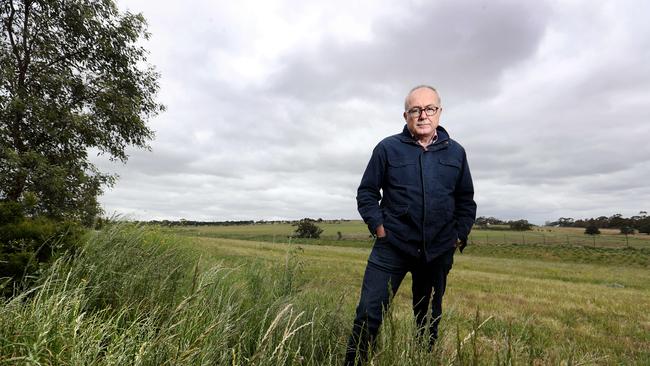How China’s pig problem is saving our bacon

In the US, Christmas hams are up 70 per cent. The cause is something far more sinister — African Swine Fever in China.
The implications of this disease breakout, the devastating impact on the Middle Kingdom and the remarkable opportunity that it presents to Australia is only just reaching mainstream media. It is an alarming story of national protein security, global trade and the Australia-China relationship.
With 30 years in meat trading under his belt, Simon Quilty probably knows more than anyone in Australia about the crisis. Recently returned from a trip to China, he sets out the horror of African Swine Fever.
“In 48 hours, death is imminent, and it bleeds from every orifice of the animal. Half of China’s pig population, which amounts to quarter of the world’s pig population, gone. We have seen an extraordinary event occur in global protein that in my lifetime and probably most people’s lifetimes we will never see again.”
African Swine Fever hit Henan province in August last year. Since then, Quilty says the Chinese government’s own estimates on inventory show a 41 per cent loss in hogs and a 39.5 per cent loss in sows. Before this year ends, he believes the figures will be closer to 50 per cent-60 per cent.
Pork in China has accounted for three-quarters of total pork, beef and poultry consumption.
“54 million tonnes were normally consumed per year. Now because of this disease, the Chinese will be less 15-20 million tonnes of pork per year, so it is an extraordinary loss in terms of their major protein within the country.”
So enormous is this loss that there is now a critical shortage of protein worldwide, one that Quilty believes will continue for three to five years.
Quilty uses the word “extraordinary” a lot. Pictures in China are emerging of rivers running red with pig blood. As many as 100 million have died. There is no vaccine. The disease is not a flu and not contagious to humans but that has been part of its potency.
“It is a cultural issue because of the swill,” Quilty says. “Pigs within Asia are seen almost as the garbage trucks: food scraps will go to the pigs and that is how it has spread so quickly.” The fever also spreads through processed meat. “Frozen pork will hold the virus for three years.”
Quilty’s figures on tonnage losses were higher than the US Department of Agriculture’s; that is until last week when they fell into line with his. At last month’s Leman China Swine conference in Zhengzhou, the focus was on the run on protein globally, he says. “It was really into detail. The opening speaker, Professor Qui, spoke of the same loss of 15-20 million tonnes and lasting three to five years.”
As global prices soar, the surprising winner out of all this is beef, and that includes Australian beef.
“My word,” says Quilty. “Our shipments of Australian beef this year are up 72 per cent for frozen on last year and on chilled, up 112 per cent.”
China has been the quiet saviour of an Australian beef market reeling from drought and being forced to turn off cattle for lack of feed. Quilty puts the female culls rates for the past six to eight months at between 56 and 58 per cent.
“As a result our herd I believe this time next year will sit at 24.5 million. That has not been seen since 1993, so China has been a godsend. The lowest prices we received during the height of liquidation is $5 a kilo. In years gone past, they were the prices we dreamt of during the good times. It really has been extraordinary.
“And on the back of that, I expect that when the drought eventually breaks, and within two to three years, we will see prices rebound on cattle in Australia to around $8.50 from today’s levels of about $5.20 to $5.25 a kilo.”
The action in global trade in protein — pork and beef but also lamb and chicken — is off the charts.
Quilty has customers all over the US trying of offset risk in pork and beef over the rise in prices, which he says is 40 per cent so far this year. He deals in swaps and derivatives in the Northern American market because it is better at managing risk. “I also buy beef around the world on behalf of customers, Australia, New Zealand and India and sell into Japan, China and the US.”
From the country, the son of two doctors began as an ag scientist but cut his teeth at Louis Dreyfus and then ConAgra before starting his own trading business. Quilty’s advice to customers is that there is no quick fix to China’s problem.
“I’m telling them that this phenomenon is not a short-term event as it was in 2014. This time around our forward markets here in live cattle are very strong next year and that tells us there is an underlying strength in demand that is here to stay at least for three to five years.”
China’s new love affair with beef has radically changed the status quo in meat trading: a super demand cycle, and nowhere more so than in the US.
Much of Australia’s lower quality ground beef exports that used to go to the US burger market is now being redirected to China.
“That has made the North Americans chase the market higher and imported beef is starting to drag up domestic beef in value. This week, we are almost matching the highs of 2014, when the market got to around $US3 a pound. The difference today is that the Australian dollar is at US68.5c — back then it was US90c, so we are truly seeing record prices FOB Australia for processed meat going globally both to America and to China.”
Other nations are cashing in. Argentina exports 70 per cent of its beef to China. Almost 55 per cent of New Zealand’s beef exports go to China (up 133 per cent from August 2018), and exports to the US have fallen over a third to a 19 per cent share.
Unfortunately, Australia is not matching its competition. That, according to Quilty, is due to the strain in Australia-China relations, no doubt a hot topic at The Australian’s Strategic Forum on Monday.
“The industry has taken it upon itself to try and improve those relationships, but we have two key issues of concern: one is that we have had 10 meatwork establishments sitting on the sidelines for two years that have not been registered for China. And the second is that we have a safeguard in place that when that is filled, our tariffs go up from 6 per cent to 12 per cent. Brazil had 25 meat plants approved in September; they had 10 approved this week.”
While Australia’s unregistered plants benefit from the overall rise in global prices, these are still at a discount to Chinese prices. Australia waits on the sidelines for approval.
“Yet it is not coming,” Quilty frets. “Politics, dare I say left over from the previous government. I am truly hoping that we get over that hurdle and have all the Australian plants approved. Canada got re-entry last week after three months.”
The protein market seems to be tightening almost weekly, but Quilty is pointing his clients to the dangers of a short-term dumping of pork in China around Christmas, thanks to stockpiling of pork inventory to cash in on future high prices and a requirement of Chinese state-owned enterprises to complete their key performance indicators in December. That however, will be a temporary blip and he sees the cattle price cycle kicking off for giants like AACo and smaller businesses.
“I expect within six to eight months that those prices will have improved dramatically — anywhere between 50-60 per cent higher than what they were during last year.”
In the meantime, African Swine Fever continues to spread through Asia with reports that it has reached Timor Leste, just 700km north of Darwin. Quilty questions last week’s ACIL report that potential losses from an outbreak in Australia could reach $2bn. Industry standards here are much higher than rural China, he argues, but he concedes the threat is ominous.
“It is humans that will bring it into Australia. In the last year, as I understand it, of 400 pork product samples that have been found in luggage or the mail systems, close to 50 per cent was found to have African Swine Fever. It tells us it is inherent in the food chain in China, which is concerning.”
Quilty recently attended a roundtable with Agriculture Minister Bridget McKenzie. “To her credit she is all over this, but we need the government to put more and more money into biosecurity to ensure that the disease does not enter Australia.”
Back in China, the task to eradicate African Swine Fever is daunting. At what point do you reintroduce new stock? “That’s a very good question.”



Australians will get a rude shock when they head off to buy their Christmas ham. Pork prices are up 60 per cent, and no, it is not the drought.